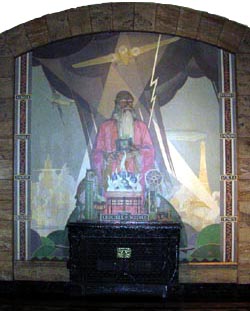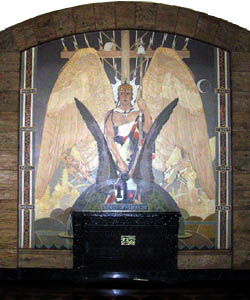Telecommunications History Group Resources
931 14th St. Historic Building
14th Street Inner Lobby - Allen Tupper True Murals
The Crucible of Science
“The Crucible of Science is an allegory in which the scientist holds in his hands Alexander Graham Bell’s first telephone while he contemplates some results of scientific development and achievement.
“At the left is the Voltaic pile which first produced induced electrical current; at the right are the microscope, Edison’s lamp, loudspeaker, telegraph instruments, and the vacuum tube. The latter, most modern of these, had a part in enabling man to talk across the ocean. Under the magic touch of the scientist’s wand there emerges from the Crucible the latest type of dial telephone. (See our Science of Phones section for more on these and other inventions.)
“In the background searchlights pierce the dark, and the aeroplane rides the storm as the lightning flashes. The border motive is the electrician’s conventional symbol for various electrical units. In it appear the names of eight of the world’s scientists who have contributed largely to our knowledge of electricity.”
Notes: If you look closely, you can see the names of eight people listed around the sides of the painting. These are:
James Clerk Maxwell (1831-1879): A Scottish physicist noted for demonstrating the electromagnetic nature of light. He showed that light travels in waves differing from heat and radio waves only in length or pitch.
Benjamin Franklin (1706-1790): A famous American scientist, philosopher, and writer, Franklin experimented with static electricity and the Leyden jar, and also charted the Gulf Stream in the Atlantic. He founded the American Philosophic Society.
Andre Ampere (1775-1836): A distinguished French mathematician, physicist, and naturalist. He showed that parallel conductors of electricity will repel or attract each other depending on the direction of their currents. The unit measuring electric current (the ampere) is named for him.
Hans Christian Oersted (1777-1851): This Danish physicist discovered that a current-bearing conductor possesses a magnetic field and will deflect a compass needle, providing the basis from which the research of Ampere, Arago, and Faraday sprung.
Herman von Helmholtz (1821-1894): A German scientist, musician, and psychologist whose paper on the Law of the Conservation of Energy is probably his most famous contribution to science, but who also studied physiological processes (hearing, sight) and whose work in this area may have influenced Bell’s work on the telephone.
Michael Faraday (1791-1867): An English scientist working chiefly in the fields of chemistry and electricity. Amongst his many accomplishments, he discovered that by rotating a copper disc (with wires attached) between the poles of a horseshoe magnet, he could induce not only a current, but a steady current that could be used in lieu of a battery to send electrical power through wires.
Alessandro Volta (1745-1827): An Italian physicist, Volta created the first battery—that is, the first way to actually store electricity for later use. In a time when there were no electrical outlets, no electric lights, and in fact no electricity at all except from lightning and from various experiments with static charges (e.g., Leyden jars), Volta’s “battery” (or voltaic pile) was the only way to begin to use electricity as a source of controllable power.
Joseph Henry (1799-1878): An American scientist who studied electromagnetic currents and demonstrated that an electromagnet (and therefore electricity) could be used to ring a bell at a distance and at will. This work inspired Samuel B. Morse to invent the telegraph.
You can find out more about several of these men in our A Time Before Phones article in our Science of Phones section.
The Wings of Thought
“The Wings of Thought is an allegory of the speed with which thought and the spoken word wing their way over the earth.
“The telephone, winged messenger of today, stands ready to carry a message anywhere at any time. Behind the messenger appears a globe representing the universality of communication. On it may be seen the Orient and the Western Coast of America.
“In the background winged messages flash between Oriental temples and the Golden Gate.”
Notes: Around the sides on this mural are eight more names, these of men who were instrumental in the development of telephone technology:
Thomas B. Doolittle (1839-1921): Doolittle invented hard copper wire. Copper wire is a good conductor of electricity but is mechanically weak. Iron wire is strong but not a very good conductor. He created the first hard-drawn copper wire made tough-skinned by a fairly simple process. This hard wire was used for line wire and vastly extended the range of telephone transmission.
Charles E. Scribner (1858-1926): Scribner spent 30 years devoted to the creation of the switchboard, the “brain” of the telephone system in 1929. Of the nine thousand switchboard patents, he held six hundred or more.
Alexander Graham Bell (1847-1922): Bell invented the telephone in 1876 as a by-product of his intense interest in teaching the deaf to speak. His invention, patented on his 29th birthday, consisted of two instruments similar in principle to 1929 receivers.
Thomas A. Watson (1854-1934): Watson was Bell’s able assistant at the time the telephone was invented. He actually constructed the first telephone instruments and heard the fist words ever transmitted by telephone.
Lee De Forest (1873-1961): De Forest invented the Audion vacuum tube (in 1906) that led to the ability to talk from this continent to almost any point in Europe. It also was used in the development of the radio broadcasting industry.
John Joseph Carty (1861-1932): Carty became famous for his ability to trouble-shoot technical problems in the system. His solutions include: the first metallic multiple switchboard, a system to mitigate noise and cross talk on telephone lines, the first transcontinental telephone circuit, the Washington-Boston underground cable and the first wireless transmission from Arlington, Virginia to Hawaii and Paris.
Thomas A. Edison (1847-1931): Among his many discoveries and inventions, Edison developed a relatively powerful transmitter, using carbon as the active element. He invented the phonograph and the kinetophone, a form of talking motion pictures. (You can learn more about Edison’s connection with the telephone–and lawsuits related to the telephone–in our The Telephone Patent Follies article.)
Michael I. Pupin (1858-1935): Pupin invented the loading coil, which extended the range of transmission many times greater than the original circuit, making possible a transcontinental telephone circuit. It allowed a fine copper wire to do the work of heavier and more expensive wire, which saved nearly $40 per mile of wire.
(Please note that the italicized text accompanying the murals is adapted from a 1929 pamphlet put out by the telephone company to promote the murals and the building.)


